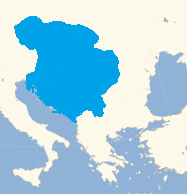The First Czech Empire, or the První Česká Říše, was a Medieval state situated in Central Europe and the Balkans during the 1400s and 1500s.

The First Czech Empire at its greatest extent.
Rise of the Czech Empire[]
After the death of George of Poděbrady in 1471, the Pro-Hussite King of the Czechs, Vladimir VI of the Plyček Dynasty came to the throne. His first action as emperor was to strip the non-Hussite nobles of their power, thus solidifying the Czech lands as primarily Hussite. In 1490, through his marriage to the daughter of the Hungarian King, Vladimir came to the throne of Hungary also. In 1509 he died, leaving the throne to his eldest son, Vladistoc I. In 1524, Vladistoc I fought a battle with the Turks at Mohács. Vladistoc's army of 40,000 (about 20,000 of which were Czech, the rest of which were Hungarian) successfully defeated the larger (50,000) army of Sultan Suleiman I. The Turks, caught in a swamp after marching the summer heat for miles, lost approximately two thirds of its strength, whereas Vladistoc's force lost only 4,000 soldiers. Crushed, the Turks were forced to retreat, and the Vladistoc's army marched farther south, annexing Serbia and Slovenia. In 1526, Vladistoc I invaded Austria and annexed the eastern most portion.
Middle Period of the Czech Empire[]
Vladistoc I died in 1534 of natural causes, leaving the throne to his eldest son, Vladistoc II. Vladistoc II was fiercely Lutheran, and by the time of his death in 1556, much of Čechy was Lutheran. Under Vladistoc II, the Czech Empire flourished, despite his relatively weak rule. Power in Čechy (also known as Bohemia) was centralized by the creation of a Parliament (Českého parlamentu) in 1536, in which nobles were brought together to make laws under the guidance of the king. Nobles were allowed a stipend from the king, but could not levy taxes over their estates (which were handed over to the king). By lessening the burden on the peasants, a population boom was triggered. The Hungarians eventually developed their own parliament in 1548 with similar results, despite weak protests from Vladistoc II.
Decline and Fall of the Czech Empire[]
Upon the death of Vladistoc III in 1556, his son Josef took the throne. The Hungarians, seeking greater autonomy, chose instead to elect their own king, Stephan I, to the throne. This started a 20 year Civil War, each kingdom claiming sovereignty. Most of this fighting was conducted in Slovakia, severely depleting the area. In 1577, Vladistoc III died in the Battle of Bratislava. The contemporary battle lines were set as permanent borders, roughly dividing Slovakia between the two nations. With no heir to the throne, the Czech Empire was throne into chaos. In 1579, the Parliament elected the Charles V, a Habsburgs of Austria to the throne, ending the Czech Empire.
Legacy[]
The First Czech Empire left its mark in many ways. First, it strengthened the feeling of the Czech national identity, leading to a powerful nation state in the 19th century. It also strengthened the Hungarian Kingdom by repelling the Ottomans and leading to a powerful dynasty. Lastly, the social innovations led to a population boom in both Čechy and Hungary, leading to a movement out of the region, and a spread of both the Czech and Hungarian cultures and ethnicities.

The various successor states of the First Czech Empire.
At right are the states which ensued after the fall of the First Czech Empire. Yellow is Austrian holdings, green is Hungarian and orange represents Ottoman lands.
